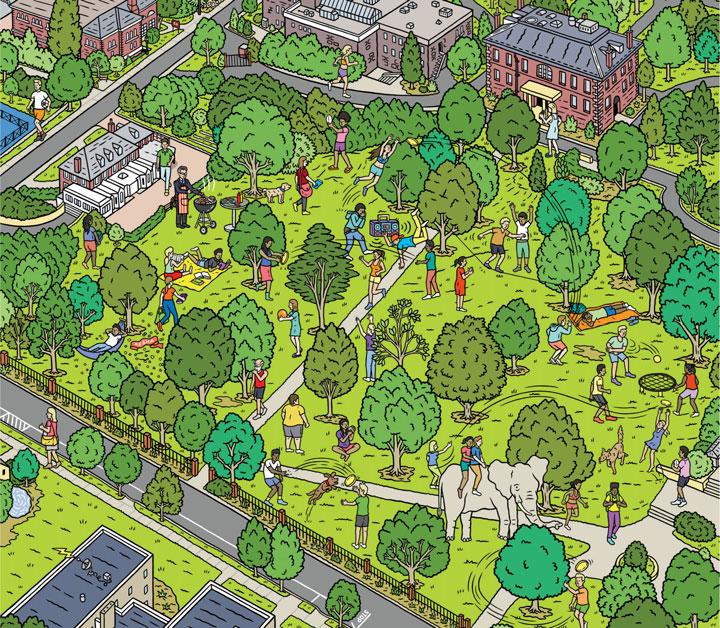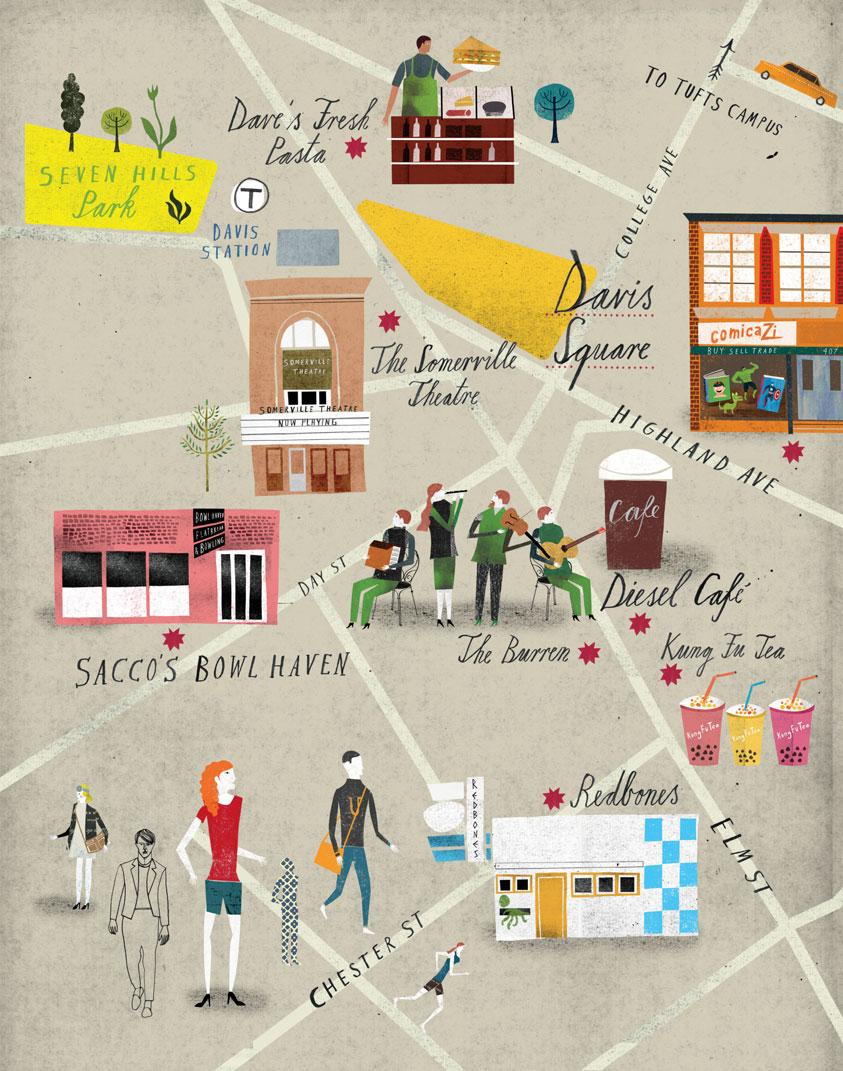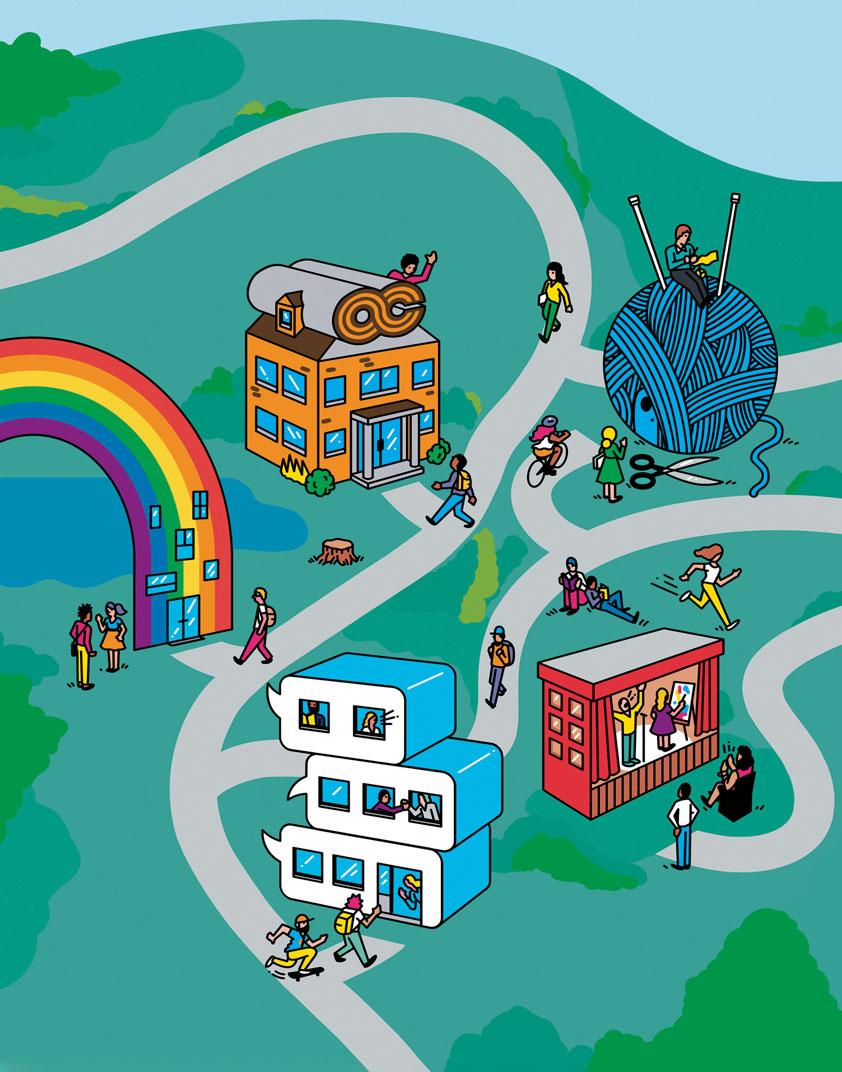
4 minute read
Test
SUMMER ON THE PREZ LAWN

Advertisement
On sunny days, Tufts students, faculty, and canines all flock to the Prez Lawn (short for President’s Lawn), where activities abound. See how many you can spot in the illustration above.
∙ President Monaco BBQing (don’t forget the ketchup) ∙ Students studying on a blanket ∙ A hammock nap ∙ A boombox blaring ∙ A Tufts Mountain Club member slacklining between trees
∙ The oldest building on the Tufts campus, Ballou Hall (notable for its pillars) ∙ Five Frisbees flying ∙ An intense game of Spikeball ∙ Three Tufts dogs (some spotted) ∙ One very large mascot
Special film festivals, intimate concerts, and the latest feature can all be found at the historic Somerville Theatre. If you arrive early for a show, grab some fresh popcorn and explore the tuckedaway art gallery in the theatre’s basement, the famous Museum of Bad Art.
Think about the best things in the world—homemade pasta, sandwiches, cheese, and chocolate—and it becomes pretty easy to understand why Dave’s is a Tufts favorite. Try the prosciutto and fig sandwich—you’ll thank us later.
A bowling alley and wood-fired pizza joint in one? Grab a pepperoni and mushroom flatbread—made with organic handcrafted cauldron tomato sauce—and hang out in one of ten lanes devoted to traditional New England candlepin bowling. You don’t have to be good at bowling to enjoy some time here (trust us).

With live music every night of the week, The Burren is renowned not only locally but nationally, earning its ranking as one of the best Irish pubs in America. Enjoy an ample menu, dancing, and a celebrity sighting if you’re lucky—Neil Young has made a few surprise appearances over the years.
From wild wall art to the best BBQ around, stop by Redbones to fill up on comfort food classics, including some crazy cornbread that we could literally eat all day. It’s a great place to take your family or enjoy a Saturday night dinner with friends.
Stop by Davis’ own comic book store to grab the latest Batgirl or Alexandria OcasioCortez comic—or peruse a full collection of longstanding favorites. This eccentric shop hosts gaming events, sci-fi book club meetings, and author panels, too.
DAVIS SQUARE AROUND TOWN

Davis Square is a quick 15-minute walk—or, in case of cold weather or temporary laziness, a five-minute free shuttle ride—from the Tufts campus. A vibrant destination for food, shopping, and live music, Davis is also a stop on the Red Line, the T (subway) line that takes passengers right into downtown Boston. But you’ll find you don’t really need to go further than Davis for a delicious meal, a coffee shop study session, or an evening of entertainment.
Rosebud is a laid-back diner with a reliable brunch, but that doesn’t mean it lacks in culinary punch. You’ll find food packed with plenty of exciting flavors—the hush puppies with pineapple and chili chutney are killer—and pie to top everything off.
For some of the best tortas in town—the campechana is practically too good to not swallow whole—and fresh ingredients all around, look no further than Tenoch. As a nice bonus, the food truck comes to campus for special occasions; you can spot it by the long line.
LIVING FEELS LIKE HOME
Beyond traditional residence halls, special interest houses offer the opportunity for students to engage with shared interests under shared roofs, while building communities that embrace their identities.
2
1

4
5
6
9
8
7

1. Rainbow House: The Rainbow House fosters a community welcoming of all gender identities and sexualities. Through hosting seasonal on-campus activities and attending Boston events, housemates seek to confront issues of gender and sexuality and, moreover, better celebrate the intersectionality of their own identities.
2. Capen House: Residents of Capen House, in collaboration with the Africana Center, host yearround public events and community projects to celebrate the culture and history of the African Diaspora. Individuals who are interested in living in Capen House must propose three potential programs when applying to live in the House.
3. Crafts House: As Tufts’ only cooperative living option, Crafts House hosts nightly open dinners and frequent workshops to celebrate members’ individualities “when they can’t find their identity represented elsewhere” (Alix Kaplan ’21). Topics explored by residents include sexual and gender identity, political activism, and artistic exploration.
4. Language and Culture Houses: (French, German, Spanish, Muslim, Chinese, Japanese, Jewish, Russian): Through daily interactions with their housemates as well as weekly coffee hours open to non-resident language learners, residents have abundant opportunities “to build upon what is learned in class” (Emily Lazorchak ’21) or connect through shared cultures.
5. Arts Haus: Whether they are bonding over Bob Ross and Boba or hosting themed art-making nights, Arts Haus residents build and foster a community to explore different creative media and create a “place to call home” (Priya Misner ’20).
6. Asian American House: Housemates work closely with the Asian American Center to “create a community centered on political education” (Issay Matsumoto ’21). They promote cultural awareness through public events such as traditional cultural events and thought talks with esteemed Asian guest speakers.
7. Green House: Green House residents collaborate with other eco-friendly students, organizations, and faculty to promote healthy habits for sustainable living. Through their frequent on-campus projects and initiatives, Green House residents provide Tufts students many opportunities to “live more green.”
8. Latinx Culture House: Also known as La Casa, this house provides residents the “opportunity to stay engaged in the Latinx community” (Ana Brasil ’21) through a tight-knit support group connected by shared walls. The house operates in conjunction with the Latino Center and supports its residents closely in their academic and social endeavors.
9. International House: Typical conversation topics between I-House residents range from Turkish coffee to Nepalese food to different cultural values in Myanmar and India. People who choose to live here leave “learning more about other countries and taking a bit of their passions” with them (Anne Lau ’21).

